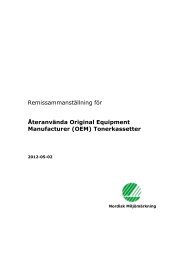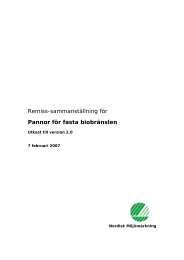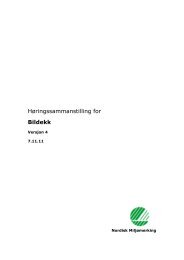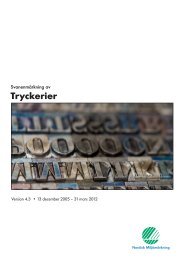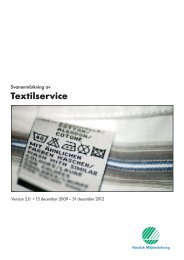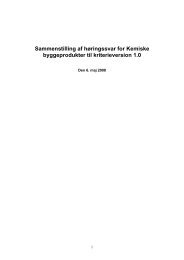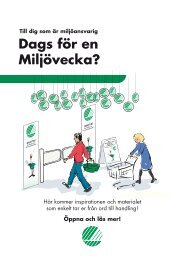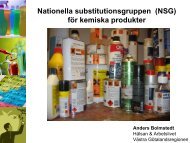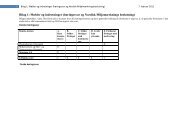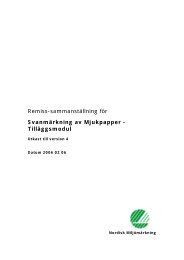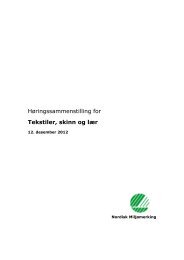Småhus, flerbostadshus och förskolebyggnader - Svanen
Småhus, flerbostadshus och förskolebyggnader - Svanen
Småhus, flerbostadshus och förskolebyggnader - Svanen
You also want an ePaper? Increase the reach of your titles
YUMPU automatically turns print PDFs into web optimized ePapers that Google loves.
Nordisk Miljømerking<br />
Hus, leiligheter og barnehager 089/versjon 2<br />
Høringssammenstilling, oppdatert 10. august 2010<br />
5.5. Andre krav til byggprodukter, materialer og interiører<br />
O28 Fasade og takbekledning<br />
International Zinc Association<br />
Galvanised products and products made of zinc emit zinc and zinc compounds to the<br />
surrounding environment (especially water and earth) where they can accumulate in the<br />
food chain.<br />
On the suggested accumulation of zinc in the food chain, the conclusion of the EU risk<br />
assessment is clear: “it is concluded that secondary poisoning is considered to be not<br />
relevant in the effect assessment of zinc. Major decision points for this conclusion are the<br />
following. The accumulation of zinc, an essential element, is regulated in animals of<br />
several taxonomic groups, for example in molluscs, crustaceans, fish and mammals. In<br />
mammals, one of the two target species for secondary poisoning, both the absorption of<br />
zinc from the diet and the excretion of zinc, are regulated. This allows mammals, within<br />
certain limits, to maintain their total body zinc level (whole body homeostasis) and to<br />
maintain physiologically required levels of zinc in their various tissues, both at<br />
low and high dietary zinc intakes. The results of field studies, in which relatively small<br />
differences were found in the zinc levels of small mammals from control and polluted<br />
sites, are in accordance with the homeostatic mechanism. These data indicate that the<br />
bioaccumulation potential of zinc in both herbivorous and carnivorous mammals will be<br />
low. Based on the above data, secondary poisoning and the related issues ioaccumulation<br />
and biomagnification are not further discussed in this report”. (Risk Assessment Zinc<br />
metal, ECB 2008, page 292).<br />
Zinc itself is a trace element without particularly toxic properties.<br />
Zinc is an essential element for all life forms and it is required to ensure normal growth<br />
and development. Nature and humans have a natural regulating system for zinc allowing<br />
for adequate uptake/elimination, in accordance to the nutritional needs. The Predicted No<br />
Effects Concentrations (PNECs), set in the zinc risk assessment report, therefore<br />
recognize zinc excess as well as zinc deficiency and integrate the concepts of zinc<br />
bioavailability. Van Sprang et al. (2009) have gone through a revision of the zinc risk<br />
assessment using the most recent and up-to-date scientific concepts and<br />
bioavailability tools. Over the nine European river basin studied, deterministic risk<br />
characterization ratios were all below one, suggesting that there is no deterministic risk<br />
associated with current use patterns of Zn in these river basins.<br />
Zinc causes the release of cadmium since cadmium is an associated substance in zinc.<br />
Today’s rolled zinc has to comply with European Standards, as defined by<br />
CEN/CENELEC Internal Regulation. Those standards, prepared by TC CEN/TC 209<br />
define products requirements, in this case specifications for rolled flat products for<br />
building, including zinc. In such application zinc is alloyed with copper and titanium, and<br />
it has a content of 99.995% zinc Super High Grade Z1, which is compliant with EN1179<br />
standard. The EN1179 standard specifies that zinc cannot contain more than 0.003%<br />
148 (165)



